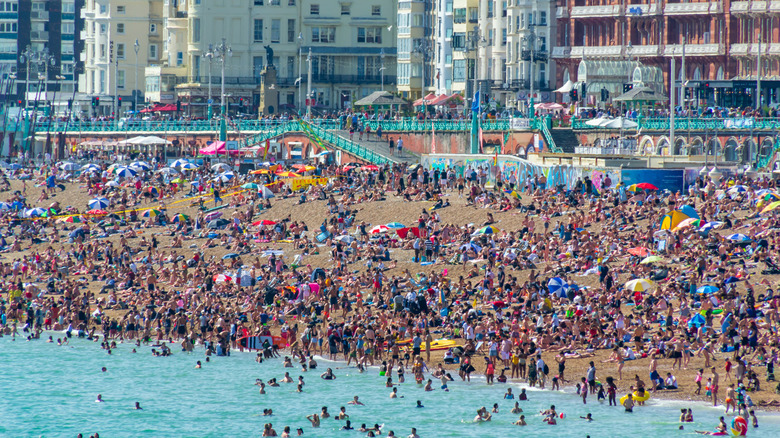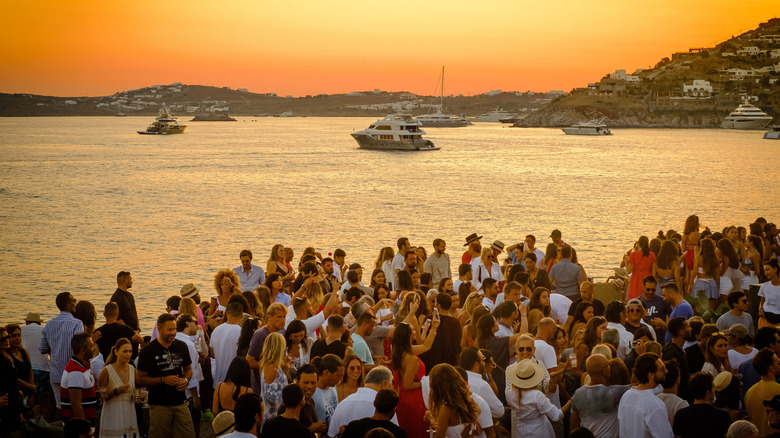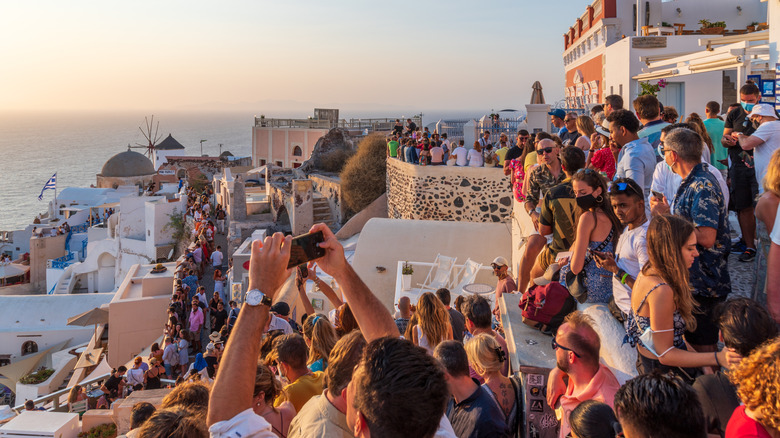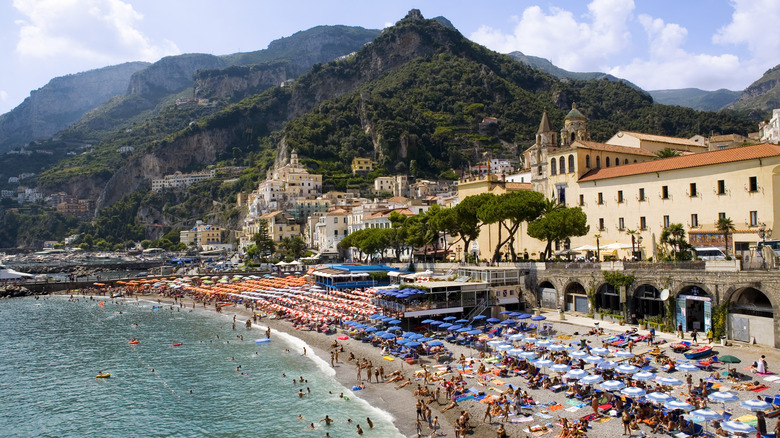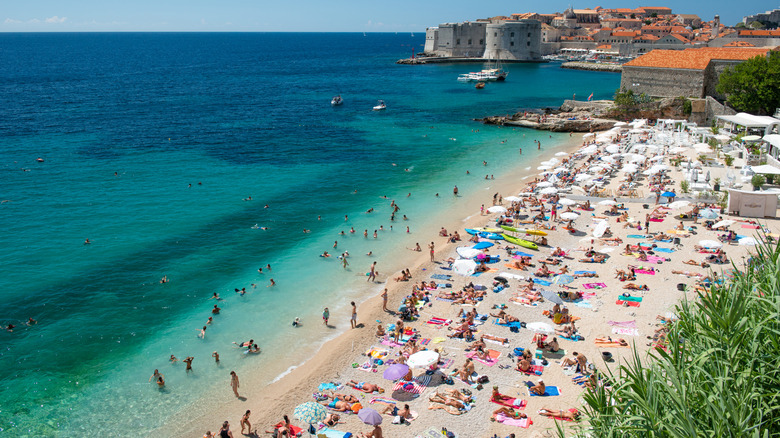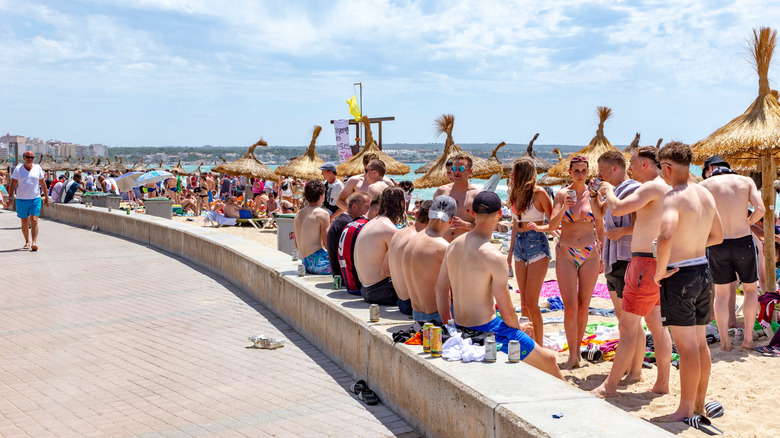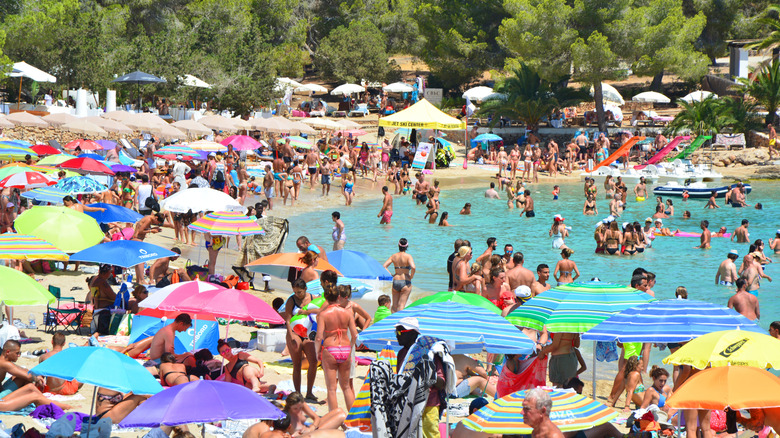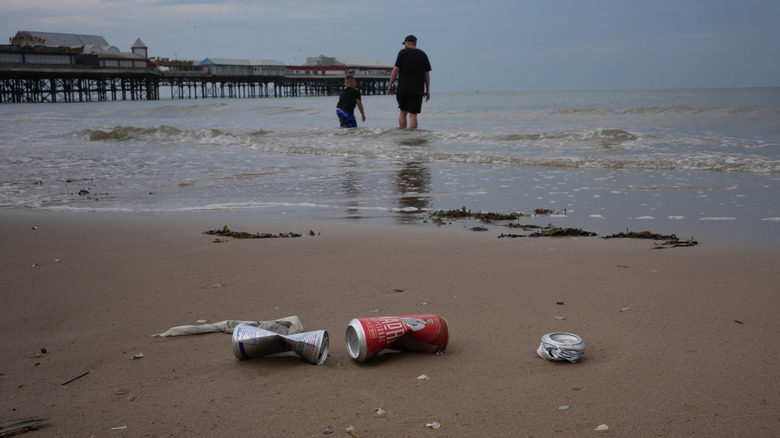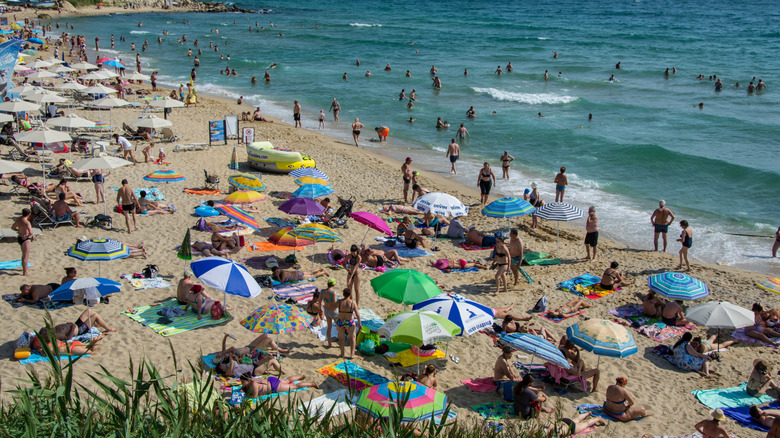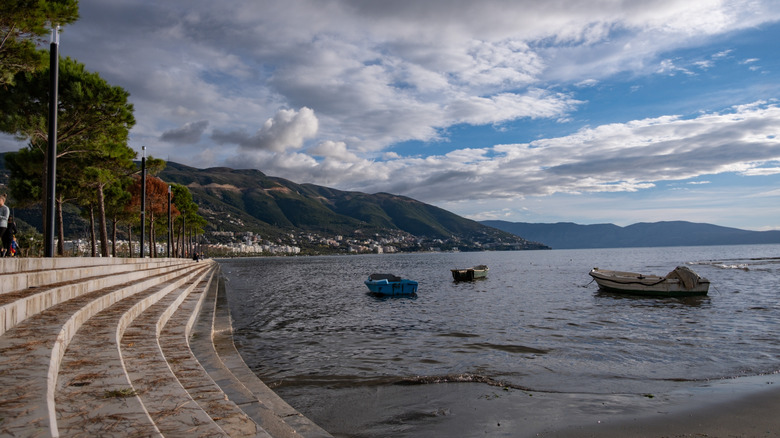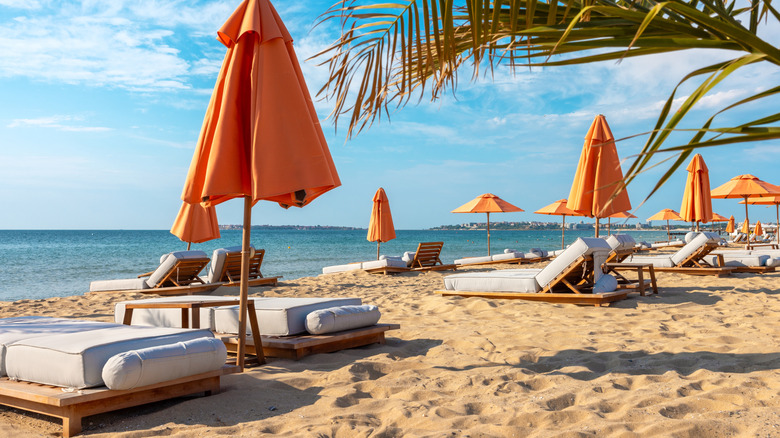9 Beach Destinations In Europe You May Want To Skip, According To Travel Experts
A summer spent on Europe's beaches is the stuff of dreams. From spritzes on the turquoise waters of the Aegean to the wondrous sands of the Med, the continent's coasts have been irresistible for travelers for centuries. Unfortunately, today's world of hyper-saturated social media illusions makes it hard to tell fantasy from reality. That stunning little beach, jewel-toned and glittering beneath an impossibly beautiful village, looks like heaven, but as every seasoned traveler can tell you, there's a good chance those angles are covering up a lot.
Many of Europe's greatest beach spots are facing unprecedented crowding, excessive commercialization, over-pricing, and, in some severe cases, pollution. Those postcard-perfect locations can be frustrating places to visit, and offer more of an exercise in patience than a relaxing day by the water. That's not to say they should be totally avoided — they were popular in the first place for a reason. It just takes a little extra planning or the willingness to seek out some underrated alternatives nearby.
To help you make the most of your next Euro-trip, we scoured the internet for travel experts with their fingers on the pulse of trending destinations and found 10 of the most sought-after beach spots in Europe, and then explained why you might want to give them a miss this time. There are thousands of beaches scattered across Europe, don't tie yourself to an elbow-to-elbow sunbed with over-priced beers. Unless that is your idea of a good time, of course.
Mykonos, Greece — Expensive and overcrowded
Think of Greece's beach destinations, and Mykonos is one of maybe three names that will spring to mind (the next place on this list is one of the other two). Its whitewashed architecture, epic beach clubs, and luxury vibe make it a hotspot for social elites across Europe, but that reputation has come at a cost. As influencers and high-end party seekers flock to its shores, prices have soared, and elbow room has shrunk. Spots like Paradise Beach, Super Paradise, and Psarou all do the rounds on social media as pristine beaches, but the reality nowadays means you'll barely see the sand for the crowds. With DJs every hundred meters or so, it's turned many of the beaches into mini-festivals starting before noon.
And with that, the prices have also increased. Lounger rental rates have soared, driven by high demand, and a cocktail in the sand is breaking New York and London prices. Many of the beach clubs require a minimum spend with a sun bed — not hard to do considering you can hit $50 with a couple of drinks. Some of the bars are even notorious for shadowy pricing, with some insane stories highlighting prices upwards of $400 for a few drinks and lunch.
As Jackie Rezk of JouJouTravels (quoted in the Sun) put it: "Mykonos is expensive and so crowded that you lose all the beauty and charm it became famous for." If you're still set on Greece, swap crowded Mykonos for Kos, a more affordable Greek island with just as many golden sand beaches. While popular, it's nowhere as pricey and can give you the experience you probably came searching for in the first place.
Santorini, Greece — Perfect on Instagram, but not in reality
Greece has it rough when it comes to this topic. With two spots on the list, it's its own fault for being so pretty. Santorini is one of the most photographed places on the planet, and its white and blue buildings, cascading down the cliffside toward the volcanic bay below, are breathtaking. However, as millions flock there every year, many are a little confused when they realize the beaches aren't what they expected, and the key factor is the volcano we mentioned earlier. The island is part of a caldera, basically the sunken crater of a volcano, and that means the beautiful golden beaches found elsewhere aren't there. Instead, you find black pebbles and dark, gritty sand, both absorbing the hot sun and making it almost impossible to stand on during the day. It looks amazing, but it's nowhere near ideal for a relaxing day by the water.
And then there's the crowds. For every idyllic snap, there's a video showing the long lines of tourists waiting to grab the shot. It's the perfect example of how social media warps the reality of a place. Restaurants and beach bars pounce on the demand, putting hefty mandatory spend on bookings, bumping prices, and not necessarily improving the quality to match. Often, what is meant to be a serene break ends up chaotic and expensive, and with the old town never designed to cope with crowds that size, it's a logistical nightmare.
As Emily Luxton from Dorset Travel Guide (per the Express) pointed out: "Santorini always looks perfect on Instagram ... Instead, you get elbow-to-elbow crowds and overpriced everything!". But remember, Greece has well over a thousand islands. Instead of Santorini, try Skiathos, a less crowded alternative with stunning beaches to boot.
Amalfi Coast, Italy — Gorgeous, but crowded and expensive
Moving west to Italy, we've got the Amalfi Coast. Few destinations have exploded in popularity like the Amalfi in recent years. The borderline perfect 34-mile stretch of coastline has 13 towns and villages for tourists to choose from — and they're all feeling the surge. Its dramatic cliffs and winding roads are built for a beach-punctuated road trip, but it's on those sandy strips that the illusion begins to dissipate. There aren't that many beaches, and they're all relatively small and pebbly. Geography has dictated this, forcing tourists down narrow staircases to crowded little alcoves with designer parasols hovering over sun beds. In summer, almost every inch is claimed, making privacy almost impossible.
The awkward beach set-up hasn't impacted soaring prices, though. Sun beds come at a premium, often hitting upwards of 80 euros a day, especially at more exclusive clubs, and drinks or food can quickly climb into the hundreds for a couple. Your best bet is finding a hotel with a private beach, but again, you can expect to pay for the privilege. The logistics of the whole day often put tourists off and change their view on what they assumed was a top-notch beach destination. In reality, they may have been better off trying to experience the real Amalfi Coast, with this inn-to-inn hike through vineyards and lemon groves.
Travel writer Anna Kloots noted: "The Amalfi Coast is gorgeous, it is also crowded, expensive, and full of tourists." So if it's a beach vacation you're searching for, maybe look elsewhere in Italy. Puglia and Calabria both offer larger beaches for a more traditional experience than Amalfi's densely packed pebbles. Plus, they're far cheaper.
Dubrovnik, Croatia — Overcrowded to the max
Croatia — and Dubrovnik in particular — spent years as something of a hidden gem in Europe. While marketing may try to suggest that's still the case, the region is now firmly challenging many of Europe's tourist heavyweights. And it should be popular: Dubrovnik's stunning Venetian walls (of "Game of Thrones" fame) and Adriatic Sea perch make it an unbelievable combination of sun, sea, and history. But that combo is popular, and the crowds have swarmed. That issue is compounded in peak season, as multiple cruise ships dock in the harbor, sometimes doubling the number of visitors in a single afternoon. The Old Town's narrow streets become a crowded maze, and the nearby beaches are equally packed.
Similar to the Amalfi Coast and Santorini, Dubrovnik's beaches are often pebbly, which is a major turn-off for some. If you can brave the pebbles (bring a pair of water shoes or good flip flops), it then becomes a battle for space. Even Banje Beach, one of the best beaches in Dubrovnik — a spot with Old Town views, an after-dark party vibe, and a family-friendly atmosphere — can be chaotic. The sustainability of the beaches and Old Town tourism has been front of minds for locals in the past few years, with many calls for a ban or at least limits on cruise ships.
Responsible Travel pointed out: "Dubrovnik has been ranked the most overcrowded city in the world, with 27 tourists to every resident at its peak." For a Croatian beach break, consider Korčula or Vis, which have similar Adriatic beauty but far fewer visitors. Dubrovnik is worth visiting for its history and views, but if you're chasing the perfect beach day, give it a miss.
Mallorca, Spain — A party island overrun by tourists
Unlike some of the other destinations already mentioned, Mallorca has no issues with its actual beaches. It has a staggering array of sandy golden stretches, some more intimate options further afield, and a few darker sand or pebbly beaches. That's why it has been a prime destination for Europeans in search of cheap beach holidays for decades, but, as with many geographically blessed spots, it has been a victim of its own success. Every year, thousands of young tourists flock to the island in search of cheap booze and late-night clubs. The beaches the next day serve as hangover recovery centers or another pre-game spot for the night's festivities.
While still often marketed as a relaxing getaway, many new visitors find themselves shocked by the overdevelopment, noise, and overall atmosphere. While it is possible to find some quieter spots on the island, the central hubs where many gravitate for convenience tend to be the epicenter for the chaos. Hotels and bars have sprung up on every beach, many of them catering directly to foreigners, offering the surreal experience of walking into a British or Dutch-owned bar in the middle of a paradise island.
Travel writer Sanne Wesselman of Spend Life Traveling (who lived there for two months) explains: "Mallorca has a bad reputation. It is seen as a cheap holiday destination; a party island overrun by young tourists wanting to get drunk every night." The good news is that many of these areas are self-contained and can be avoided with some research. Start here, by checking out some of the best things to do in Mallorca beyond the beaches.
Ibiza, Spain — Not for unspoiled beaches
Also found in the Balearic Islands, Ibiza is the world's nightlife Mecca. Its ultra-cool beach clubs, incredible nightclubs drawing the world's best DJs, and even a high-end culinary scene make it a constant draw for those wanting to see and be seen. Once again, that popularity has transformed once tranquil beach spots into party hubs that blast music and revelry well into the early hours of the morning.
The commercialization of Ibiza's beaches means you can expect higher prices and less authenticity — unless you're talking about an authentic Mediterranean Club feel. Most of the strips of beaches are controlled by the restaurants and clubs that line them, making access contingent on pricey cocktails and sunbeds and proximity to hundreds of party-goers looking for a good time. Playa d'en Bossa, San Antonio, and O Beach are the big hubs for the Ibiza party scene. If you're in search of a different vacation, avoid those spots or head to a neighboring island.
The Fit Traveller agrees with this notion, advising travelers to: "Experience the quiet side of Ibiza ... well away from the crowds of clubbers." She highly recommends the less-developed north side of the island, where things move at a slower pace, far from the pounding basslines of electronic music.
Blackpool Beach, England — Dirty and downmarket
Blackpool is something of a beloved relic in the U.K. Once one of the world's most glamorous tourist hotspots, it fell on hard times and never really recovered. That wasn't its fault. As air travel became more accessible, the British middle class had more options, opting to spend time in the guaranteed sunny climes of the Mediterranean. Blackpool remains popular in its own right, thanks to its illuminations, old-time pier, and Pleasure Beach theme park, but as a beach spot, it's not looking so good.
Aside from the notoriously temperamental British weather making it a tough place to bet on the sun, recent years have seen the water quality take a massive dip. Multiple reports place Blackpool's beaches among the worst in the country for pollution, with warnings against swimming a regular occurrence. Blackpool North, one of the most popular beaches, was deemed the second dirtiest in Britain according to The Sun. The blatant health risks, combined with the weather, are closing the door firmly on Blackpool remaining a beach destination of any sort.
That's not to say you shouldn't visit. The city's self-aware kitschiness is delightful in its own right. While much of that is nostalgia fueled by older generations, and felt more keenly by other Brits than foreigners, it's an interesting place to visit, as it represents an immense turning point in the world of tourism. Just don't plan your trip hoping for a dip in the Irish Sea. For a slightly more reliable beach trip, head further south, where the weather is a little (emphasis on the little) more predictable and warm. Margate, a quirky town in the south of England, boasts sandy beaches, art galleries, and a mysterious underground grotto, and could serve as a perfect alternative.
Varna, Bulgaria — Pollution problems
Bulgaria may not be high on the list of many American beach-going tourists, but its affordable reputation, hot summer weather, and some stunning beaches have made it a steadily growing option for many European travelers. Varna, often called the "Sea Capital" of Bulgaria, thanks to its position on the Black Sea, has evolved into a popular resort city. At first glimpse, it could pass for a Mediterranean beach town, with its sprawling sandy beaches framed by Eastern Orthodox church domes and rows of hotels and restaurants. However, the destination has faced some intense scrutiny recently, owing to the quality of its water.
Pollution has been a major problem for Varna, with sewage dumps often leading to full beach closures and swimming bans. Some recent studies have found traces of oil in the water along the coast, which is being investigated by experts. Luckily, things have been improving, and the waters in the region have moved into an acceptable level once again — although areas further up the coast still have better readings than Varna, according to Bulgaria's Ministry of Tourism.
Even when things are looking safe, Varna can get very busy. Bars and clubs dominate the waterfront, with many young foreigners in search of cheap alcohol making their way to the city. What may feel like it's going to be a relaxing, hidden gem can quickly turn into a chaotic day out. Other options on the Black Sea are Albena to the north of Varna and Sozopol in the south. Both are excellent choices with strong water quality.
Vlorë, Albania — Dirty and underdeveloped
Albania is still something of a newcomer in the European tourism space. Those who have stumbled across the nation's wonders will know how special it is — and how likely it is that overtourism will come knocking soon. While its inland cities are spectacular, as are the excellently named Accursed Mountains, its beaches are the primary draw for the ever-increasing number of visitors. Sharing the Adriatic coastline with Greece, it's often marketed as a cheaper alternative to its southerly neighbor.
Vlorë (or Vlora) has become one of the country's premier beach destinations. At first glance, the beach town's shorefront has the feeling of a quaint European answer to Miami's South Beach. The broad sandy shoreline, with the mountains in the background and a lovely row of restaurants and hotels, shows all the makings of a top beach destination. Sadly, the beaches themselves are poorly maintained. Trash is reported all over the area, roadside developments impart a noisy atmosphere, and the local infrastructure has struggled to cope with the increase in demand. One particularly troubling aspect is the regular mass burning of waste in the city, turning the skies black with smoke for short periods and wafting unpleasant smells across the area.
While the potential is there for Vlorë to become a true gem in the country's tourist offerings, the way the city is coping with the surge has left a lot to be desired. If things pick up in the near future, it will be well worth a stop, thanks to its unique surroundings and great weather, but for now, swinging south towards the pebbly delight of Himarë or further down the coast to Ksamil and Sarandë is the better option.
Methodology
This list could have been curated in many ways. The simplest would have been to find the worst beaches in Europe, classified by crowding, pollution, crime, or some other metric. Instead, we opted to research destinations that are immensely popular for their beaches and provide an insight as to why they may have been victims of their own success. Social media has made it hard to tell what beaches are practical, beautiful, or crowded, while others are overrun by younger groups intent on partying throughout the day and night.
Once we'd narrowed down the destinations, we set about finding travel experts, bloggers, journalists, and other travelers who had experienced them firsthand and shared the opinion. The writer has also visited many of the destinations on the list. Many of the destinations can still be enjoyed by tweaking things, switching to another side of the city, or just embracing the chaos. Either way, the list can help serve to avoid any unwanted surprises on your next European beach vacation.
